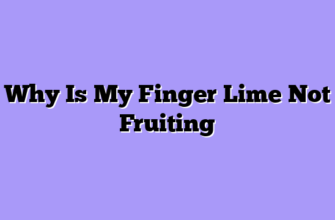After two decades of growing exotic citrus, I can tell you that fertilizing finger limes is nothing like feeding your typical orange or lemon tree. These Australian natives, scientifically known as Citrus australasica, have completely different nutritional needs than their commercial citrus cousins. Whether you call them caviar limes, lime caviar, bush limes, or native finger limes, these remarkable plants require a specialized feeding approach that I’ve perfected through years of trial, error, and careful observation.

The secret lies in understanding that Citrus australasica evolved in the nutrient-poor soils of Australian rainforest margins. Unlike commercial citrus that’s been bred for generations to thrive with heavy feeding, finger limes actually prefer a more restrained nutritional approach. Think of it like the difference between feeding a pampered house cat versus a wild lynx – both are felines, but their dietary needs are worlds apart.
Understanding the Unique Nutritional Profile of Bush Limes
Finger limes have what I call a “Goldilocks complex” when it comes to nutrition – everything has to be just right. Too much nitrogen, and you’ll get beautiful green foliage but virtually no fruit. Too little phosphorus, and those characteristic vesicles won’t develop properly. The key is finding that sweet spot where your caviar lime trees are getting exactly what they need, when they need it.
In my experience, the biggest mistake most growers make is overfertilizing. I’ve seen beautiful finger lime trees that look like they should be producing pounds of fruit but barely give you a handful of small, poorly formed limes. The problem? Too much love in the form of excessive nitrogen.
Here’s what I’ve learned about the specific nutritional requirements of Citrus australasica through years of soil testing and plant tissue analysis:
Primary Macronutrients:
- Nitrogen: 2.5-3.0% (much lower than standard citrus)
- Phosphorus: 0.15-0.25% (critical for vesicle development)
- Potassium: 1.2-1.8% (essential for fruit quality)
Secondary Nutrients:
- Calcium: 2.0-4.0% (prevents fruit splitting)
- Magnesium: 0.3-0.7% (chlorophyll production)
- Sulfur: 0.2-0.4% (protein synthesis)
The micronutrient profile is where things get really interesting. Native finger limes have evolved to be incredibly efficient at extracting trace elements from poor soils, which means they’re sensitive to micronutrient excesses. I learned this the hard way when I first started using standard citrus fertilizer blends and ended up with iron toxicity symptoms.
My Seasonal Fertilization Strategy
Over the years, I’ve developed a fertilization calendar that works consistently across different soil types and climate conditions. This isn’t a one-size-fits-all approach – you need to adjust based on your specific growing conditions – but it provides a solid foundation.
| Season | Fertilizer Type | N-P-K Ratio | Application Rate | Key Focus |
|---|---|---|---|---|
| Early Spring | Slow-release organic | 8-3-9 | 2 oz per tree | Growth initiation |
| Late Spring | Balanced liquid | 10-5-10 | Monthly feeding | Flowering support |
| Summer | Low-nitrogen blend | 5-8-10 | Bi-weekly | Fruit development |
| Fall | Potassium-rich | 3-5-12 | Reduce frequency | Hardening off |
Spring Awakening (March-April): This is when your bush limes are waking up from winter dormancy. I use a gentle, slow-release organic fertilizer with an 8-3-9 ratio. The moderate nitrogen helps push new growth without encouraging excessive vegetative development. I apply about 2 ounces per mature tree, scratched into the soil around the drip line.
Late Spring Push (May-June): As temperatures warm and flowering begins, I switch to a liquid fertilizer program. This is crucial timing because finger limes need readily available nutrients during their flowering period. I use a balanced 10-5-10 liquid fertilizer diluted to half strength, applied monthly. The phosphorus boost during this period significantly improves fruit set.
Summer Sustenance (July-September): Here’s where my approach differs dramatically from standard citrus fertilization. I actually reduce nitrogen and increase phosphorus and potassium. My summer blend is typically 5-8-10, applied every two weeks as a liquid feed. This promotes proper vesicle development and prevents the common problem of large, hollow fruits with poorly developed internal structure.
Fall Preparation (October-November): As harvest approaches and trees prepare for dormancy, I shift to a potassium-rich formula (3-5-12) applied less frequently. This helps harden off the wood for winter and improves cold tolerance.
Organic vs. Synthetic: What Works Best for Caviar Limes
I’ve experimented extensively with both organic and synthetic fertilizer programs, and honestly, the results surprised me. While I expected the organic approach to win hands down, the reality is more nuanced.
Organic Fertilization Program: My organic program centers around composted chicken manure, kelp meal, and rock phosphate. I apply composted manure twice yearly – once in early spring and again in late summer. The kelp meal provides excellent micronutrients and seems to improve the flavor intensity of the vesicles. Rock phosphate gives me the phosphorus boost needed for proper fruit development.
The organic approach produces finger limes with superior flavor complexity and longer shelf life. Restaurant chefs consistently tell me they can taste the difference. However, growth rates are slower, and it takes longer to establish young trees.
Synthetic Fertilization Program: My synthetic program uses controlled-release fertilizers supplemented with liquid feeds. I’ve had excellent results with Osmocote Plus 15-9-12 applied three times per year, combined with monthly liquid feeding during the growing season.
The synthetic approach gives me faster growth, earlier fruit production, and higher yields. Young trees establish more quickly, and I can fine-tune nutrition more precisely. However, I’ve noticed that over-reliance on synthetic fertilizers can lead to softer wood and increased susceptibility to pest problems.
My Hybrid Approach: After years of testing, I’ve settled on a hybrid system that combines the best of both worlds:
- Base nutrition from organic sources (compost, kelp meal)
- Supplemental synthetic fertilizers for precise control
- Liquid organic feeds during critical growth periods
- Synthetic micronutrient supplements as needed
- Foliar feeding for quick corrections
This approach gives me the flavor benefits of organic growing with the control and efficiency of synthetic fertilizers.
Micronutrient Management: The Devil’s in the Details
Here’s where many finger lime growers stumble – micronutrient management. These Australian natives have evolved very specific requirements for trace elements, and getting it wrong can spell disaster for your crop.
Iron: This is the big one. Finger limes are incredibly sensitive to iron levels. Too little, and you get chlorotic leaves and poor growth. Too much, and you get iron toxicity with bronzing leaves and stunted development. I maintain soil pH between 6.0-6.5 to optimize iron availability and use chelated iron supplements only when tissue analysis indicates deficiency.
Zinc: Critical for proper fruit development. I apply zinc sulfate twice yearly – once in early spring and again in mid-summer. Signs of zinc deficiency include small, poorly formed fruits and mottled leaf patterns.
Manganese: Essential for chlorophyll production. I’ve found that finger limes grown in alkaline soils often show manganese deficiency symptoms. Foliar applications of manganese sulfate work well for quick correction.
Boron: Necessary for cell wall formation and fruit development. Too little boron results in thick-skinned fruits with poor vesicle development. I apply borax at 1 ounce per mature tree annually.
Common Fertilization Mistakes and How to Avoid Them
Let me share some expensive lessons I’ve learned over the years:
Mistake #1: Overfertilizing with Nitrogen I see this constantly with new growers. They want fast growth and heavy fruit production, so they load up on nitrogen. The result? Beautiful, lush foliage and almost no fruit. Finger limes are not heavy feeders, and excess nitrogen actually inhibits flowering and fruit set.
Mistake #2: Ignoring Soil pH Finger limes prefer slightly acidic to neutral soils (pH 6.0-7.0). In alkaline soils, they can’t access nutrients efficiently, no matter how much fertilizer you apply. I test soil pH annually and adjust with sulfur or lime as needed.
Mistake #3: Using Standard Citrus Fertilizers Most commercial citrus fertilizers are formulated for heavy-feeding varieties like oranges and grapefruits. They’re too rich for finger limes. I’ve had much better success with fertilizers designed for native plants or acid-loving crops.
Mistake #4: Neglecting Foliar Feeding The waxy leaves of finger limes can absorb nutrients efficiently through foliar application. I use foliar feeding for quick corrections and to supplement soil applications. A monthly foliar feed with liquid kelp extract works wonders.
Soil Testing and Monitoring: Your Fertilization Compass
You can’t properly fertilize what you don’t measure. I conduct comprehensive soil tests annually and plant tissue analysis every two years. This data drives my fertilization decisions and helps me avoid costly mistakes.
Annual Soil Testing Protocol:
- pH and buffer pH
- Electrical conductivity (salt levels)
- Organic matter content
- Macronutrients (N-P-K)
- Secondary nutrients (Ca-Mg-S)
- Micronutrients (Fe-Zn-Mn-B-Cu-Mo)
- Cation exchange capacity
Plant Tissue Analysis: I collect leaf samples in late summer when nutrient levels are most stable. This tells me exactly what the plant is actually absorbing, not just what’s available in the soil.
| Nutrient | Optimal Range | Deficient Below | Excessive Above |
|---|---|---|---|
| Nitrogen | 2.5-3.0% | 2.0% | 3.5% |
| Phosphorus | 0.15-0.25% | 0.10% | 0.30% |
| Potassium | 1.2-1.8% | 1.0% | 2.2% |
| Calcium | 2.0-4.0% | 1.5% | 5.0% |
| Magnesium | 0.3-0.7% | 0.25% | 1.0% |
| Iron | 60-120 ppm | 50 ppm | 200 ppm |
| Zinc | 25-100 ppm | 20 ppm | 150 ppm |
The beauty of regular testing is that you can catch problems before they become visible. I’ve prevented numerous nutritional disasters by adjusting my fertilization program based on test results rather than waiting for symptoms to appear.
Troubleshooting Common Nutritional Problems
After years of growing finger limes, I’ve become pretty good at diagnosing nutritional issues. Here are the most common problems I see and how to fix them:
Poor Fruit Set: Usually indicates nitrogen excess or phosphorus deficiency. Reduce nitrogen and increase phosphorus during flowering season.
Small, Hollow Fruits: Often caused by inadequate potassium or inconsistent watering. Increase potassium levels and ensure consistent soil moisture.
Vesicles Lack Flavor: Typically results from over-fertilization or insufficient stress. Reduce overall fertilization and allow plants to experience mild water stress between irrigations.
Leaf Yellowing: Could be nitrogen deficiency, iron chlorosis, or waterlogged soil. Soil testing is essential for proper diagnosis.
Slow Growth: Often indicates pH problems preventing nutrient uptake. Test and adjust soil pH first before increasing fertilizer rates.
The key to success with finger lime fertilization is patience and observation. These plants reward careful, consistent care rather than heavy-handed feeding. Think of yourself as a chef creating a perfectly balanced recipe – every ingredient matters, timing is crucial, and less is often more.
My finger lime trees now produce consistently excellent fruit that commands premium prices from top restaurants. The secret isn’t in pushing the plants harder with more fertilizer – it’s in understanding their unique needs and providing exactly what they require, when they require it. That’s the difference between growing finger limes and growing exceptional caviar limes that capture the essence of their Australian heritage while thriving in your local conditions.








